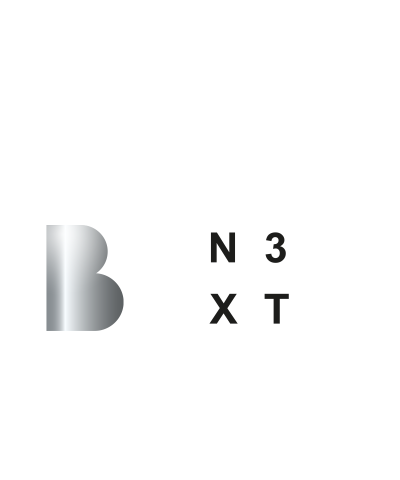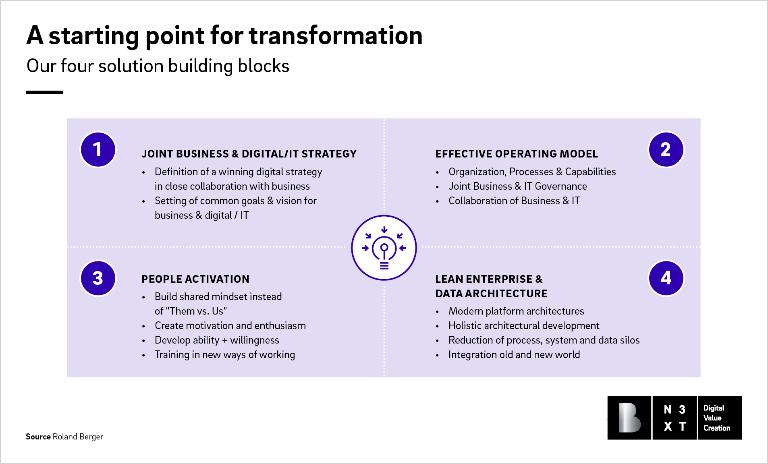

One DigITal: An approach to unify digital and IT functions and transform your business
Most digital initiatives fail – combined business and digital/IT strategies ensure they don’t
Digitalization is a challenging and unforgiving process. Indeed, most digital initiatives fail. But it doesn’t have to be this way! We believe that by bringing their business and digital/IT strategies together in a one DigITal strategy, companies can smooth their path to digital success, regain strategic freedom and increase their profits. Here we outline our approach.

"Our agile approach to digital transformation allows for rapid incremental gains on the way to fundamental change."
No one thinks of digitalization as a mere buzzword anymore. Rather, companies recognize that it’s now a business necessity. Transforming away from legacy systems and adopting new digital ways of working ensures strategic freedom of action, speed in bringing new offerings to market and a chance to upgrade operating models and employee skills. It’s also more profitable.
But the reality is that 70% of digital initiatives fail. Factors such as an unwillingness to adopt new agile methods and poor communications between business and IT departments undermine transformation efforts, leaving key challenges – keeping up with competitors, selecting the right business topics, reorganizing value chains etc. – unmet.
However, we believe that by bringing their business and digital/IT strategies together in a one DigITal approach, companies can overcome these challenges and realize their digital and IT ambitions.
Four building blocks for a successful transformation
We have developed four complementary solution building blocks that offer companies the freedom of action to shape digitalization and quickly implement digital projects:
- Joint Business & Digital/IT Strategy
- Effective Operating Model
- People Activation
- Lean Enterprise & Data Architecture.
These combine to deliver several key results:
- Clear customer focus
- Optimized time-to-market for digital solutions
- Reduction of project risks
- Increased operational efficiency
- Reduced redundancies and silos
1. Joint Business & Digital/IT Strategy
The first task here is to develop an overarching target picture to help visualize how the company’s business and digital/IT functions can better collaborate and drive a joint business and digital/IT strategy.
This should center on a digital and data journey layer, comprising internally developed software that supports all processes end-to-end. Feeding into this should be process development teams (agile expert groups to build the data journey layer), customer operations teams (to provide market data), computers and databases (to enable standardization) and external services (to manage third-party software).
The second task is to integrate digital, IT and business functions. The focus here is on collaboration: for example, senior IT personnel need to be involved in strategy development, while business units must continuously coordinate on the implementation of individual projects.
2. Effective Operating Model
Agile IT systems promise enormous opportunities, but they still need to operate alongside core IT systems during the transformation. The requirements of both must therefore be considered to ensure the new operating model delivers a faster, more efficient and customer-oriented business.
For example, the new model must ensure core IT remains stable and reliable, while creating space for agile systems. Waterfall and agile approaches must also sit comfortably together, and traditional teams need to work effectively alongside small, cross-functional teams of specialists.
3. People activation
The right mindset, training and cultural changes are key pillars of a company’s digital transformation. For example, from top management down, employees must have an accepting and “can do” attitude.
Training talent and ensuring people are motivated are equally important goals, with measures tailored to individual hierarchies. Cultural adaptations are also key. We suggest prioritizing a minimum viable product culture (developing products with minimal resources/effort and then iterating), as well as modular project design (to split projects into digestible chunks and increase responsibilities).
4. Lean Enterprise & Data Architecture
No transformation can take place without the necessary infrastructure. We believe the establishment of a comprehensive enterprise architecture management (EAM) function is key to turning a joint business and IT strategy into a flexible enterprise architecture. By enabling state-of-the-art platform architectures and robust standards, EAM allows holistic control of an organization’s enterprise architecture. It also offers faster times to market, reduction of complexity and lower operating costs.
However, EAM does not suit legacy systems. As such, the complexity of existing business/IT architecture must be reduced and replaced by a modular structure.
The one DigITal approach: How to realize your transformation
Our agile approach to digital transformation allows for rapid incremental gains on the way to fundamental change. We suggest starting small by concentrating on one of the four building blocks to deliver quick returns. Then, once more experience has been gained, combining building blocks to realize exponential results.
Register now to download the full study and to learn more about the four building blocks to enhance your digital journey. Get also regular insights into our Roland Berger N3XT topics.


